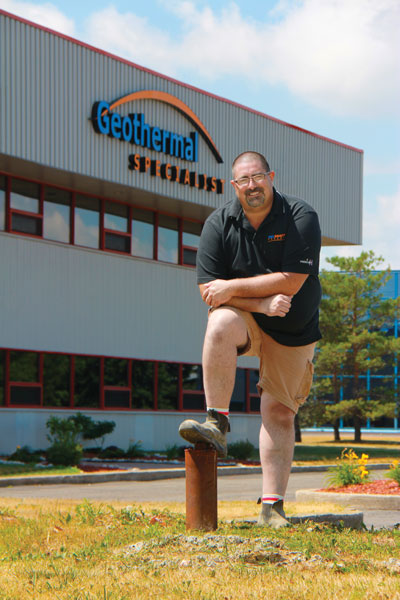
Features
Geothermal
Drilling with Paul Catton
A chat with GeoSmart’s chief driller.
September 12, 2011 By Brandi Cowen
Although he’s only been with GeoSmart Energy for a short time as drilling manager, Paul Catton accounts for almost a quarter-century of the knowledge and skill that have helped establish the company as a leader in the renewable energy market.
Although he’s only been with GeoSmart Energy for a short time as drilling manager, Paul Catton accounts for almost a quarter-century of the knowledge and skill that have helped establish the company as a leader in the renewable energy market.
 |
|
| Photo credit: Chris Bruer, GeoSmart Energy Advertisement
|
Ground Water Canada sat down with Catton at the company’s Cambridge, Ont., headquarters to pick his brain about being a geothermal driller.
How did you get started in the drilling industry?
I graduated from Sir Sandford Fleming in 1987 from the drilling program, and started working in the industry directly out of that. I’ve done environmental drilling, water well drilling, all sorts of different aspects of it throughout Ontario. Then around 2004 or 2005, I started to focus on geothermal. I actually bought a rig and was doing exclusively geothermal. About, four or five months ago, I joined GeoSmart in an effort to try and build its brand.
How do you design a geothermal system?
A lot of it comes from the engineering side. The input that I would have on the drilling side is more about the geology and what we anticipate we’re going to hit – potential challenges like gas pockets, salt water, maybe a little bit more challenging geology, things like that. But the overall design comes from the software and experience over the years.
Location will determine whether it’s going to be a horizontal or vertical pond loop. Obviously if space is an issue, vertical could be the only option. At that point, basically what you’re doing is using what you know about the area geographically to size the loop to meet the demand of the unit. A general rule would be 180 feet per three tonnes of capacity. You may do holes that are 360 feet, they may be 540 feet, depending on what you can do in that area, but generally the deeper the better.
There’s good information available through some of the ministry mapping and things that have been done. After Walkerton, they divided the province up into watersheds and did big hydro-geological studies of all the regions. That information’s available on the Internet. You can get ideas of depth to bedrock, types of overburden, the rock you should encounter and things like that. You can get a pretty good handle on what you’re going to get. Beyond that, it’s experience – knowing that in this area you could run into some problems.
I have the advantage, having been in the industry and worked right across Ontario, of having a pretty good idea of what’s in certain areas, maybe areas to stay away from and things like that.
How does installing a residential system differ from installing a commercial one?
The steps involved are basically the same. You drill a hole to whatever depth you’ve determined is relevant according to ministry guidelines. So that part is really the same. Where commercial varies is in the overall scope and size. A house may only require 720 feet of drilling, where commercial buildings could be 5,000, 10,000, 20,000 [feet]. It really is just overall scope for the most part.
What are some of the challenges facing the geothermal industry right now?
I think a big barrier is access to good, qualified, drilling contractors. That’s hurt the vertical side of the business growing. There’s access to working capital – it’s a big expense to get into the drilling side of the business so that can be a barrier for some. It’s not so much a lack of policing, but there are lots of rules and guidelines in place; lack of education and enforcement of those, I think, does hurt the industry a little bit.
What’s the most memorable installation you’ve been involved in so far?
We did one, a glass house that was built years ago, and the original house was done with geothermal. It was 30 years old, so that would have been some of the first-generation systems. It was in a nice area, all nicely landscaped, and it was done horizontal.
We ended up doing a vertical because they didn’t want to ruin the landscaping. We put the system in – it was a six tonne – and we put it in an area 15 x 15 [feet] in the guy’s front yard, right out front of his house. The homeowner was 80 plus years old. He’d designed the house; he was an architect in his day. He sat for three days and watched us drill out the glass window. On his sofa, eating ice cream, he was having a party — it was hilarious. I felt like we were on TV.
To do a job like that where they’d had a system in and were happy with it under pretty extreme conditions, and then to get another system put in and to do it vertically was a neat thing to do. This was somebody who really believed in the technology.
Editor’s note: This interview was edited and condensed.
Print this page